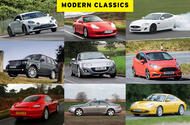Legendary and thrilling cars with a whiff of nostalgia for affordable prices. Where's the catch?
The term 'modern classic' may well be an oxymoron. And to the uninitiated, even the best modern classic car could be mistaken for just another piece of street furniture.
But if the expression is good enough for Penguin Publishing, frankly it’s good enough for us. I for one can certainly see the parallels between a Mercedes G-Wagen and The Great Gatsby, a Lamborghini Diablo and A Clockwork Orange and a Lada Niva and Animal Farm.
In years gone by, the word 'classic' conjured images of old boys in MGBs, en route to the Dog and Duck’s annual autojumble. Modern car mags and websites stuck well clear of the word.
At the same time, classic car publications were keen to not alienate their audiences with cars whose readers might think were better suited to a McDonald’s car park.
But today electric cars, clean air zones and speed cameras are battering enthusiasts at either end of the car venn diagram into the eventual intersection: the modern classic.
Dave Edmonton, founder of Pistonheads and a man Chris Harris described as the “biggest single influence on the car media area in the last 20 years†summed it up perfeclty: “Rarity, nostalgia and relative affordability all at once? What’s the catch?â€
What are modern classic cars?
Like with the aforementioned book series, modern classic cars are game-changing in their own right, and the specifics about age are purposefully vague.
Ed Callow from online auction platform Collecting Cars told us: “I think at their core, modern classics are the ‘democratised’ part of the collector car market. It’s not easy to pinpoint specific start and end years for the modern classic era, but what we tend to mean is vehicles produced in the 1980s, 1990s, and very early 2000s – from the modern period of car design and construction."
For the purpose of this list, we've kept it to cars from after 2000.

